


Confused About Bridge Cameras? You Should Be!
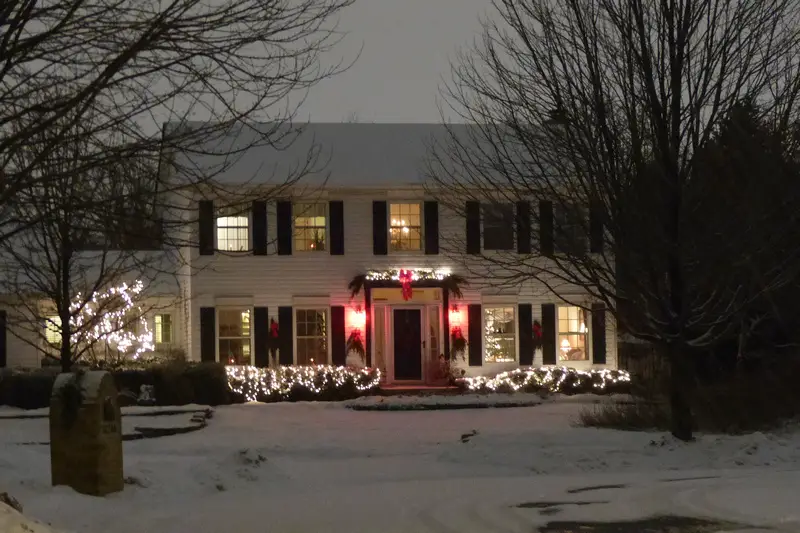
Late at night while snowing, an ISO1000 capture at 1/5 second, handheld with the Panasonic FZ-200, just as it came from the camera. Below, a quick application of the in-camera star filter to make the scene a bit more festive.
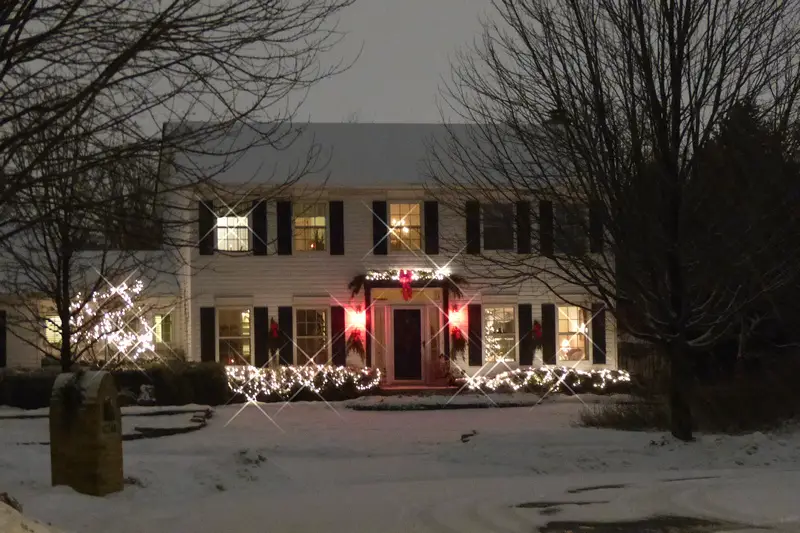
Much of the entire
camera review area is horribly redundant. By that, I mean you often have
1) a cut and paste of a Press Release followed by a "new article"
2) a "Hands on Preview" which once again regurgitates the press
release, perhaps some add copy, and is a meaningless non-review. Finally,
maybe, 6 - 8 months later you might have 3) a review, or not. Many cameras
never make it to 3), for they are already discontinued and new models
are announced, as in the case right now in several areas.
The bridge camera is supposed to bridge the divide between pocket cameras and system cameras, more or less. Yet, there is no consensus as to what that specifically means.
Right now, PC Magazine has the new $699 Olympus Stylus 1 camera as its Editor's Choice SuperZoom. It is called a SuperZoom, although it is only a 10.7x optical zoom camera. It replaced the Panasonic FZ-200 24x unit, that can now be had for $410 or even less. The Fujifilm X-S1 26x camera was beat out by the Panasonic. In October, 2012 (yes, way, way back then) the comment was “At close to $800 the X-S1 is prohibitively priced for many buyers, which prevents it from ousting the Nikon Coolpix P510 as our Editors' Choice superzoom camera.” By the way, you can now pick up the Fujifilm XS-1 for $350 delivered, if not less.
This is just one example, of many, sure to either bewilder people, or convince people that PC Magazine (and other sources) are completely bewildered. How can a 10.7x camera, in 2013, be a “SuperZoom” compared to a 24x, 26x, or 50x unit? How can a camera like the Fujifilm that retailed at $799 for a short while be overpriced, yet now the comparatively short-range $700 Olympus is the best SuperZoom you can buy? As fast as you can change your socks, the best SuperZoom went from a 42x Nikon P510 to a 24x Panasonic FZ-200 to a 10.7x Olympus. A 10x zoom range camera is no super zoom: that range of non-versatility is handily exceeded by dozens of 20–24 x eight ounce pocket cameras.
WHAT IS A BRIDGE CAMERA?
The idea of a bridge camera is to give you more versatility, features, and flexibility than available in a shirt-pocket camera with one lens array: with less bulk, weight, and cost than going the D-SLR or other system camera route. One lense array means the sensor and processor can be optimized for that one lens. One lens means the unit is sealed to a certain extent, so no dirt will cover your sensor when changing lenses, for example. A bridge camera should also net you an electronic viewfinder, better battery life than a point and shoot, and should be a lot more fun to carry than a system camera.
THE BETTER BRIDGE CAMERAS, AND WHY
Fujifilm X-S1
The Fujifilm X-S1 is better built than most all of them, with a larger sensor than the common 1/2.33 arena sensors, and better image quality, in general, than small-sensor cameras. Currently, it is a screaming deal at $350 street. You might wonder why I don't use one, currently? Its images can be quite excellent: http://www.flickr.com/groups/x-s1/ . The barrier, for me, is its 2.1 lb. or so weight, just more than I want to carry all day. But, that's what you get if you want a larger sensor, lens, and metal dials and a tougher build. If the weight is not an issue, and a manual zoom appeals: it may well be your camera. The EVF of the XS-1 is comparatively huge at 0.47-inch, approx. 1440,000 dots. Many other popular cameras have dinky .21 inch EVF's . . . and that includes the Canon SX-50 and Panasonic FZ-2000.
Canon SX-50
The Canon fills the frame when other cameras struggle. While the impressive focal length 50x lens isn't the brightest, its sensor is spectacularly good for a small sensor: or, at least the sensor / processor combination. Competitively priced currently at $329, its somewhat plasticy, slippery build makes the camera more fun to carry at about 1.3 pounds. The weight difference between this unit and the X-S1 is substantial, for the Fujifilm unit weighs over 60% more. If you want the massive 1200mm 35mm equivalent reach to fill your frame for stills, this camera has got it.
Panasonic FZ-200
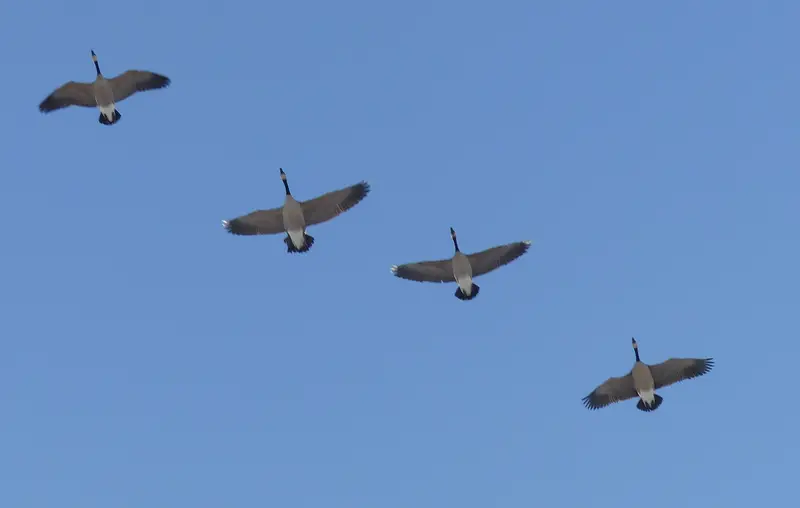
A great, bright, constant 2.8 lens and blazing fast shooting performance is why you'd want this camera (long at or near its $599 retail price point, it is now down to $409 as of this writing). Its 24x zoom range (600mm max focal length in 35mm equivalent) is less than half of the Canon SX-50 and the bargain-priced Fujifilm SL1000 50x camera ($250 or so), but 24x handles a lot of shooting opportunities and the digital “Intelligent Zoom” gets you to 48x if needed while still capturing quite enjoyable images. It is one of those rare cameras that is very good for both still images and video. I'm asked if the FZ-200 is “okay for birding” and wildlife. Vickie has answered that for us: http://www.flickr.com/photos/myssvictoria/sets/72157631256362528 .
As far as ease of use, as far as I'm concerned . . . it couldn't be easier. Set it to "P" (program mode), contrast to +1, sharpness to +1, Noise Reduction to -1 (or -2), Intelligent Dynamic to "Low," use Intelligent ISO (that helps a bit with subject movement), and be prepared to capture terrific images. Naturally, you can tweak things to a far greater extent as you please, with the full array of PASM modes, the omnipresent IA (intelligent Auto) mode, the expected array of scene modes, specialty in-camera filters, and so forth.

Above, a hand-held FZ200 image of raccoon statues that aren't readily seen.

Now, the same shot, hand-held, using the full optical zoom of the FZ200.

The uppermost raccoon, at 100% crop.
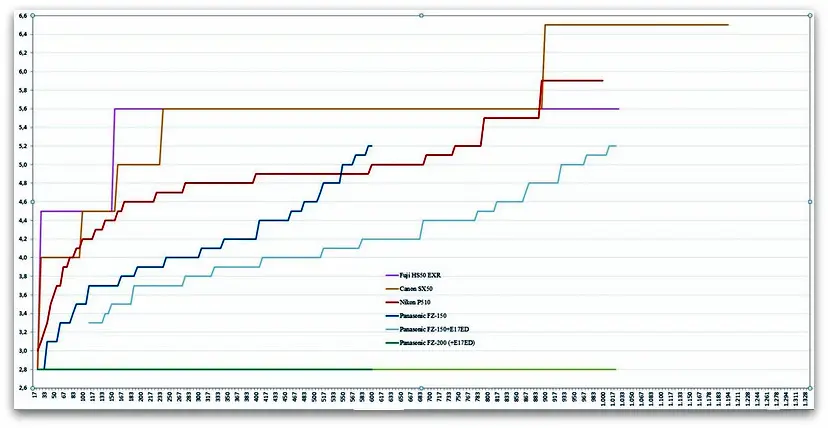
The
above graph shows how minimum aperture changes in concert with focal length
on five different bridge cameras.
CONCLUSION
All three of these cameras (X-S1, SX-50, FZ-200) can be considered excellent. It isn't that one camera could be rationally picked as a winner, for all of them have the ability to do a fine job under most conditions. Price is invariably a factor, for you can always squander the extra cash on food, clothing, and shelter.
If value is your primary concern, presently the $250 or so street price Fujifilm SL1000 is hard to beat. Its huge zoom range is the same as the bit more expensive SX-50, although the Canon is generally better unit if you want to fill the frame with a 1200mm 35mm equivalent focal length.
The Fujifilm XS-1 has the best image quality in the field, and the best build quality as well. Now available at $350, it would be called a “no-brainer” by some. While I understand that, cannot really disagree, its roughly 2.2 pound weight is more than I want to carry all day and as I do take a lot of video, the manual zoom of the XS-1 is a negative for my purposes. If the weight is not an issue for you, it is a superb unit.
There is no right or wrong or “correct” answer for everyone, for you can have a lot of fun with all of these cameras. Although I still use a Canon SX-50, the camera that does the most for me most of the time is the Panasonic FZ-200. Here's why I prefer it.
It is substantially lighter than the X-S1, it locks autofocus in extreme low-light situations (deer after sunset feeding in a field, for example) where the SX-50 struggles. While its EVF is not as good as the X-S1, though small (.21 in.) it is far sharper than the SX-50 with 1.31 million pixels.
The Panasonic FZ-200 spanks the SX-50 in video performance, focus speed, overall shooting speed and boot-up time, and has a panorama mode that the SX-50 (and Canon in general) refuses to implement. Its excellent video performance is complimented by excellent battery life (540 still shots CIPA standard). Video is invariably a big drain on batteries, as is cold weather, and both video and cold weather are common situations for me. The 120 fps 720p (lower HD) high speed video mode is superb. It is a 1/4 speed, smooth as glass, high-resolution playback. The same goes for the VGA (640 x 480) HS mode that is 240 fps: more than sufficient quality to analyze a golf swing with no post-processing.
The constant F2.8 lens of the FZ-200 is no gimmick and it gives this camera the ability to function where other super-zooms cannot. Under well-lit conditions, there isn't much difference in image quality. In fact, the Canon SX-50 is slightly better to my eyes under bright shooting conditions, if only marginally so. Under ridiculously poor light, there is a huge difference.
To compare, I took several pictures of an igloo-shaped doghouse in the snow after midnight using three representative bridge form-factor cameras, all hand-held. The Panasonic FZ-60 lost its mind, and could not begin to focus. The Canon SX-50 whirred, clicked, struggled and told me to “raise flash.” It took an unrecognizable, muddy black image of nothing discernible. The FZ-200, however, locked focus instantly and grabbed an ISO 1600 image of the doghouse, zoomed in to fill the frame, with no issues. In this somewhat contrived example, it is the difference between an instant, usable image and just no image at all.
A bit more real world test was performed outdoors with the same three cameras, at 9:30 AM on a utility junction box forty yards away, surrounded by snow, with hazy, overcast skies. The FZ-60 captured at ISO 320 / F/5.2, the SX-50 at ISO 320 at F6.5, the FZ-200 at ISO 100 / F2.8. Already, the other cameras are well away from base ISO, needing 320% of the sensor sensitivity while the F200 able to stay at ISO 100. Imatest results for the FZ-200 yielded a sharp 1811 lines per picture height, with noise held below 1.5% to ISO 800, noise at just 1.7% at ISO 1600. In daylight, it is very difficult to get the FZ-200 to need more than its base ISO of 100, with ISO 200 happening only deep in the dark woods when ambient light is filtered through the timber.
If you view F2.8 as 100% light flow, F4.0 is 50, and F5.6 is 25%. Having four times the light to work with is not trivia, actually more than four times the light in the case of the SX-50 when zoomed in. The story of the FZ-200 is summed up primarily by its lens and its blazing fast processor. Yet another test was performed on the old igloo-doghouse, half an hour before sunrise, hand-held. While the FZ-200 operated at F2.8, the Canon was forced to use a F5.6 aperture for the same shot.

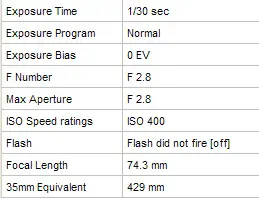
Above: the pre-dawn doghouse, just as it came from the camera, resized but unprocessed. Despite the low-light and low contrast conditions, the 429mm 35mm equivalent zoom easily filled the frame @ ISO 400, yielding a low noise blur-free image with a light Bokeh effect. Under the vast majority of outdoor shooting conditions, you'll be hard pressed to get the camera to shoot above ISO 200, unless you tell it to. The SX-50 lens starts at F3.4. At this 429mm focal length, it has already closed down to F5.6.
Though under many conditions, you can get quite pleasing images with several cameras, for a 1-1/4 lb. audiovisual standalone media powerhouse unit, the FZ-200 is the one to beat.
Copyright 2013 by Randy Wakeman. All Rights Reserved.




